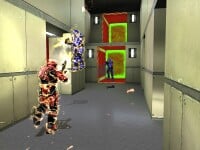Multiplayer
From Halopedia, the Halo wiki
The term 'Multiplayer' generally refers to the ability of most video games allowing for more than one person to play the game at the same time in a non-campaign setting. Multiplayer can consist of split-screen, system link, or Xbox Live. In the Halo games, multiplayer has been regarded as a core element to the game's design and a giant part of the success of the Halo franchise.
Halo: Combat Evolved

The multiplayer component of Halo: Combat Evolved for the Xbox was limited to only split screen and four Xbox consoles together for System Link play.[1] Players could also play on six others that did not exist in the console version.[2] Only a few types of games are available: they include Capture The Flag (CTF), King of the Hill, and Slayer. The ability to create and join servers over the internet was an option for online play, but there were no official standards, ranking system or function that allowed players to compete in an organized way.
The PC version has multiplayer over the internet and can have up to 16 players and custom game types.
In Halo Custom Edition, the add-on made by Gearbox Software, many maps that were unavailable to Halo: Combat Evolved have been made playable specially for Custom Edition. For example, a version of the Halo 2 and 3 map "Zanzibar" (Last Resort), had been specially created for Halo: Custom Edition. Many customized maps have new and custom game content, such as new player models, new textures and often new weapons. Specific modifications to weapons, vehicles and even the appearance of the character can be made using a special suite of programs, called the HEK.(Halo Editing Kit)
Halo 2
Multiplayer was completely redesigned for Halo 2. Built around the framework of Xbox Live, players now had more options available. Bungie's custom created interface called "matchmaking" allowed players to search for games in a variety of different playlists, such as Team Objective, Slayer, or FFA. Each play list offers a number of unique game-types from that list. Players could also create and host their own custom games, and invite other players and friends to join. The lobby system, or "virtual couch" (as players call it) was also introduced, allowing players in one "party" to stick together after games, to continue playing, or be taken to a different lobby..[3]
Putting Microsoft's TrueSkill system to use, Bungie employed a ranking system that displayed a level (1-50) based on how well a player played in a particular playlist. Rankings were for individual playlists, and players who would continually win games in a certain playlist would rank up in that playlist only. Bungie also split their multiplayer component into two major categories; ranked and unranked. While the ranked playlists offered players a chance to display skill, the unranked playlist was a more social setting that allowed guests, and did not carry ranks.[4]
Halo 3
In Halo 3, Bungie enhanced its multiplayer service, redesigning the user interface allowing for a smoother, more integrated experience. Halo 3 kept the same multiplayer options that were available in Halo: Combat Evolved and Halo 2, but added a new co-op system which supported 4 players in campaign in System Link or Xbox Live. Bungie improved upon the already stable lobby system and enhanced its effects, while tweaking and modifying their matchmaking algorithms to ensure fairer play. Halo 3 also uses a new ranking system that it split into two distinct types; skill points and rating or Rank (Halo 3 Multiplayer)|rank]] points. A player may move independently through each system, gaining rating points in either ranked or social play, or skill points in ranked play only.[5] Finally, custom games were enhanced with the addition of Forge, a multiplayer weapon, spawn and object editor. In Forge, players get to choose if they want to be a Spartan/Elite or a Monitor, and they can switch simultaneously. In Forge there is a budget, which once it runs out, you cannot add more items. Each item costs more.
Profiles and Emblems
The profile creator in Halo: Combat Evolved was very basic, though players had the ability to create a unique name, customize their armor color and change the game controls and settings. With the addition on online multiplayer through Xbox Live, the profile creator in Halo 2 was redesigned and altered. In keeping with the settings and adjustments from the previous game, Bungie added more color variants to the palette. In addition, the major change was the addition of Covenant Elite model for players to use, rather than the standard UNSC Spartan model. To identify players better on the battlefield, Bungie included a "multiplayer emblem" in which players could customize the look and color to distinguish themselves.[6]
The updated profile creator in Halo 3 gives players a host of different options to change, tweak and modify their multiplayer avatar. Again, the options from the previous games are included. However, the newest of these options include Armor Permutations for the left and right shoulders, the helmet, and the chest piece. Different armor permutations must be unlocked by gaining achievements, completing the campaign or completing certain levels on certain difficulties, or finding all the skulls.
The list of multiplayer emblems has been increased and players can now choose from a number of preset backgrounds as well. In addition, there are three color settings for emblems as well; primary, secondary, and background. Due to the vast amount of female gamers in Halo 2, Bungie added in a "female voice" which changes the voice of the player when you are killed. Finally, players may choose a call-sign, designated by one letter and two numbers so that players may easily recognize you on the battlefield.
Ranking, EXP, and Skill
The rank system was made for equality uses, so that users of a certain rank or skill level wouldn't have an advantage over another rank or skill level. The EXP was made so that it would somewhat determine how much you have played. Rank is also based on EXP, because the growing amount of EXP you have will raise your rank. Skill on the other hand does not determine the amount of EXP you have gained, but depends on how good you have played Halo 3 matchmaking. You can also lose skill and EXP by gaming poorly in matchmaking. On some games, you won't receive EXP or skill either because you did okay, but not necessarily good.
Medals
At the end of a game, medals and awards are given out to the players who achieved certain feats within the game. Although Halo: Combat Evolved didn't list your medals and didn't save the statistics in the post game lobby, Halo 2 and Halo 3 do. While Halo 2 had many medals, Halo 3 features nearly double the amount of medals for the player to receive. These include medals such as "Sword Spree" where the player must get five Energy Sword kills without dying, and "Incineration" where players must kill an enemy with a Flame Grenade or the Flamethrower, or the "Snipe!" where you get a head-shot with a Sniper Rifle. There are also numerous medals awarded for getting quick kills within 4 seconds between each kill. These medals include Double Kill!, Triple kill!, Overkill! and so on. These new medals enhance the game-play and give players a higher incentive to pick up weapons they might not normally touch.[7] At the end of a game, the previous game stats can be found by pressing the back button, and you are then able to view your stats and the medals you've won, you can also view all the medals you've received on matchmaking on Bungie.net. On Free-For-All and Campaign you can get Xbox 360 Achievements but 37 of the 49 achievements can be easily obtained in the Campaign (a couple are optional) and 3 of them for reaching a certain rank .(Private, Sergeant and Lieutenant respectively)
List of Halo 3 Game types
- Assault
- Capture the Flag
- King of the Hill
- Oddball
- Juggernaut
- Slayer
- Territories
- VIP
- Infection
- You can also create your own game by selecting a game type and press the X button to edit the game options, and then save it. Although, the created game will still be under one of the game types given above.
Halo 3 Mythic
At PAX 08, a screenshot online shows a multiplayer ONLY version of halo, that includes more achievements. photo proof at http://www.addictgaming.com/story.php?id=229
Trivia
- In Halo 3 a player's service tag can not be l17 (lower case L and 17) or I17 (upper case I and 17) stating that is reserved for service in the UNSC. It can also never be N64, P52,F46 or a55 but they can be achieved through some means. However, P53 and W11 are allowed.
- When a guest is playing on multiplayer, their service tag is O00 even if they try and change it through their appearance.
- In Halo 2 Multiplayer (and possibly others) sometimes when a Scorpion is blown up in just the right way (with the help of a glitch) its body will fly across the sky sometimes for minutes just spinning and bouncing.
- All Halo: Combat Evolved and Halo 3 maps have a "Recommended Number of Players" section and portion by Bungie employees, and all the minimum and maximum number of players are always set to even numbers.
- In edit mode on Forge you can delete people who are driving a vehicle (passengers and gunners will not die) whilst deleting a vehicle. The player you deleted will respawn immediately, however.
- The Halo 2 map, Backwash, is one of the most underplayed maps in Halo 2.
- The largest maps in the Halo trilogy are Sandtrap, Avalanche, Blood Gulch, Containment, Infinity, Sidewinder and Death Island.
- In Halo 2 Multiplayer leading your target with the Battle Rifle wasn't needed. However in Halo 3 Multiplayer, leading is needed to hit a moving opponent by placing the right side of the reticle on the left of an opponent's head, and vice versa.
- The only direct-to-direct map remakes in Halo 3 are Last Resort (remake of Zanzibar), Blackout (a remake of Lockout), Cold Storage (a remake of Chill Out), and Avalanche (a remake of Sidewinder).
- In Halo 2 Multiplayer or Campaign, pressing "down" on the Directional pad causes characters to put their gun down like ceasing and halting fire. Throwing all grenades and holding down the left trigger will also produce the same effect. This technique has been used in many machinimas like "Red vs Blue" or "The Codex" to make the characters appear to be in conversational, rather than combat-ready or war-prone, mode. However, only the latter method works on Xbox Live. This was disabled in Halo 3 but changed to holding down LB, RB, A, crouch, down on the D-pad for 4 seconds. However, this only works on Local and System Link games, not over Xbox Live.
- On the pause screen in Halo 3 Multiplayer, if you are the host, the "End Game" option will say: "Choose this option to put an end to the conflict before it ends itself". If you are a player, the "Leave Game" option will said: "Choose this option to embrace your cowardice and leave the game prematurely".
- The maximum number of players that can play in Halo Multiplayer (of any kind) is 16, via System Link or Xbox Live.
- Note: Players not living in the above countries can still play Halo and other games online by saying that they are living in one of the above countries.Template:Fact
- In Halo: Combat Evolved and Halo 3, players usually start with Assault Rifles or Plasma Pistol, while on Halo 2 players usually start with SMG's. (Exception: On the Halo 2 map Tombstone, by default players spawn with an SMG and Battle Rifle)
- Halo 3 maps can be overloaded by throwing trip mines out at unlimited spawn. This can cause some funny glitches like the bridge on Last Resort will disappear.
Related Links

